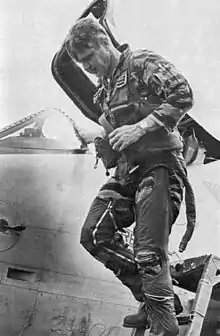James Stockdale
James Bond Stockdale (December 23, 1923 – July 5, 2005) was a United States Navy vice admiral and aviator awarded the Medal of Honor in the Vietnam War, during which he was a prisoner of war for over seven years.
James Stockdale | |
|---|---|
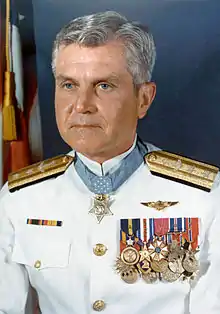 Stockdale as a rear admiral in full dress white uniform (late 1970s) | |
| Born | December 23, 1923 Abingdon, Illinois, U.S. |
| Died | July 5, 2005 (aged 81) Coronado, California, U.S. |
| Buried | |
| Allegiance | United States |
| Service/ | |
| Years of service | 1943–1979 |
| Rank | Vice Admiral |
| Commands held | VF-51 Carrier Air Wing 16 |
| Battles/wars | Vietnam War |
| Awards | Medal of Honor Navy Distinguished Service Medal (3) Silver Star (4) Legion of Merit (with "V" device) Distinguished Flying Cross (2) Bronze Star Medal (2) (with "V" device) Purple Heart (2) Air Medal (Strike/Flight 10) |
| Spouse(s) | Sybil Bailey |
| Other work | Vice Presidential candidate, 1992 |
Stockdale was the most senior naval officer held captive in Hanoi, North Vietnam. He had led aerial attacks from the carrier USS Ticonderoga (CVA-14) during the 1964 Gulf of Tonkin incident. On his next deployment, while Commander of Carrier Air Wing Sixteen aboard the carrier USS Oriskany (CV-34), his A-4 Skyhawk jet was shot down in North Vietnam on September 9, 1965. He served as President of the Naval War College from October 1977 until he retired from the Navy in 1979. As vice-admiral, Stockdale was the President of The Citadel from 1979 to 1980.
Stockdale was a candidate for Vice President of the United States in the 1992 presidential election, on Ross Perot's independent ticket.
Early life and education
Stockdale was born in Abingdon, Illinois, on December 23, 1923, the son of Mabel Edith (née Bond) and Vernon Beard Stockdale.[1][2] Following a brief period at Monmouth College, he entered the United States Naval Academy in Annapolis, Maryland, in June 1943.
Naval career
On June 5, 1946 he graduated with a Bachelor of Science degree from the Naval Academy with the Class of 1947 due to the reduced schedule still in effect from World War II. Academically he ranked 130th among 821 graduates in his class.[3] His first assignment was assistant gunnery officer aboard the destroyer minesweeper USS Carmick (DD-493) from June to October 1946. He next served aboard the USS Thompson (DD-627) from October 1946 to February 1947, the USS Charles H. Roan (DD-853) from February 1947 to July 1948, and the USS Deming (PCS-1392) from July 1948 to June 1949.
Stockdale was accepted for flight training in June 1949 and reported to Naval Air Station Pensacola in Florida. He was designated a Naval Aviator at Naval Air Station Corpus Christi in Texas, in September 1950. He was next assigned for additional training at Naval Air Station Norfolk in Virginia from October 1950 to January 1951. In January 1954, he was accepted into the United States Naval Test Pilot School at the Naval Air Station Patuxent River base in Southern Maryland, and he completed his training in July 1954. There he tutored the U.S. Marine Corps aviator John Glenn in mathematics and physics.[4] He was a test pilot until January 1957.
In 1959, the U.S. Navy sent Stockdale to Stanford University where he earned a Master of Arts degree in international relations and comparative Marxist thought in 1962. Stockdale preferred the life of a fighter pilot over academia, but he later credited Stoic philosophy with helping him cope as a prisoner of war.
Gulf of Tonkin Incident
On August 2, 1964, while on a DESOTO patrol in the Tonkin Gulf, the destroyer USS Maddox (DD-731) engaged three North Vietnamese Navy P-4 torpedo boats from the 135th Torpedo Squadron.[5] After fighting a running gun and torpedo battle, in which Maddox fired over 280 5-inch (130 mm) shells, and the torpedo boats expended their 6 torpedoes (all misses) and hundreds of rounds of 14.5mm machinegun fire; the combatants broke contact. As the torpedo boats turned for their North Vietnamese coastline, four F-8 Crusader fighter aircraft from USS Ticonderoga (CV-14) arrived, and immediately attacked the retreating torpedo boats.[6]
Stockdale (commander VF-51 (Fighter Squadron 51)), with Lieutenant (Junior Grade) Richard Hastings attacked torpedo boats T-333 and T-336, while Commander R. F. Mohrhardt and Lieutenant Commander C. E. Southwick attacked torpedo boat T-339. The four F-8 pilots reported scoring no hits with their Zuni rockets, but reported hits on all three torpedo boats with their 20 mm cannon.[7]
Two nights later, on August 4, 1964, Stockdale was overhead during the second reported attack in the Tonkin Gulf. Unlike the first event, which was an actual sea battle, no Vietnamese forces were, however, believed to have been involved in the second engagement. In the early 1990s,[8] he recounted: "[I] had the best seat in the house to watch that event, and our destroyers were just shooting at phantom targets—there were no PT boats there. ... There was nothing there but black water and American fire power."[9]
The next morning, on August 5, 1964, President Johnson ordered bombing raids on North Vietnamese military targets which he announced were retaliation for the alleged incident of August 4. When Stockdale was awoken in the early morning and was told he was to lead these attacks he responded: "Retaliation for what?" Later, while a prisoner of war, he was concerned that he would be forced to reveal this secret about the Vietnam War.[10]
Prisoner of war
On September 9, 1965, while flying from USS Oriskany on a mission over North Vietnam, Stockdale ejected from his Douglas A-4 Skyhawk, which had been struck by enemy fire and completely disabled. He parachuted into a small village, where he was severely beaten and taken prisoner.[11]
Stockdale was held as a prisoner of war in the Hỏa Lò Prison (the infamous "Hanoi Hilton") for the next seven-and-a-half years. As the senior Naval officer, he was one of the primary organizers of prisoner resistance. Tortured routinely and denied medical attention for the severely damaged leg he suffered during capture, Stockdale created and enforced a code of conduct for all prisoners which governed torture, secret communications, and behavior.[12] In the summer of 1969, he was locked in leg irons in a bath stall and routinely tortured and beaten. When told by his captors that he was to be paraded in public, Stockdale slit his scalp with a razor to purposely disfigure himself so that his captors could not use him as propaganda. When they covered his head with a hat, he beat himself with a stool until his face was swollen beyond recognition. When Stockdale was discovered with information that could implicate his friends' so-called "black activities", he slit his wrists so they could not torture him into confession.[13] During the course of his captivity, due to torture, his leg was broken twice.[14]
Early in Stockdale's captivity, his wife, Sybil Stockdale, organized The League of American Families of POWs and MIAs, with other wives of servicemen who were in similar circumstances. By 1968, she and her organization, which called for the President and the U.S. Congress to publicly acknowledge the mistreatment of the POWs (something that had never been done despite evidence of gross mistreatment), gained the attention of the American press. Sybil Stockdale personally made these demands known at the Paris Peace Talks.
Stockdale was one of eleven U.S. military prisoners known as the "Alcatraz Gang": George Thomas Coker, USN; George G. McKnight, USAF; Jeremiah Denton, USN (who had graduated with Stockdale from the Naval Academy); Harry Jenkins, USN; Sam Johnson, USAF; James Mulligan, USN; Howard Rutledge, USN; Robert Shumaker, USN (originator of the name "Hanoi Hilton"); Ronald Storz, USAF (died in captivity); and Nels Tanner, USN. Because they had been resistance leaders they were separated from other captives and placed in solitary confinement in "Alcatraz", a special facility in a courtyard behind the North Vietnamese Ministry of National Defense, located about one mile away from Hỏa Lò Prison. In Alcatraz, each of the prisoners was kept in an individual windowless and concrete cell measuring 3 by 9 feet (0.9 by 2.7 m) with a light bulb kept on around the clock, and locked in leg irons each night.[15][16][17][18][19] Of the eleven, Storz died in captivity there in 1970.[20]
The Stockdale Paradox
James C. Collins related a conversation he had with Stockdale regarding his coping strategy during his period in the Vietnamese POW camp.[21] When Collins asked which prisoners didn't make it out of Vietnam, Stockdale replied:
Oh, that's easy, the optimists. Oh, they were the ones who said, 'We're going to be out by Christmas.' And Christmas would come, and Christmas would go. Then they'd say, 'We're going to be out by Easter.' And Easter would come, and Easter would go. And then Thanksgiving, and then it would be Christmas again. And they died of a broken heart. This is a very important lesson. You must never confuse faith that you will prevail in the end—which you can never afford to lose—with the discipline to confront the most brutal facts of your current reality, whatever they might be.[22]
Collins called this the Stockdale Paradox.[21]
Return to the United States
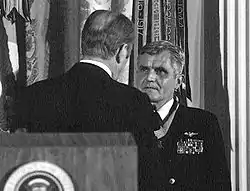
Stockdale was released as a prisoner of war on February 12, 1973 during Operation Homecoming.
On March 4, 1976, Stockdale received the Medal of Honor. Stockdale filed charges against two other officers (Marine Corps Lieutenant Colonel Edison W. Miller and Navy Captain Walter E. "Gene" Wilber) who, he felt, had given aid and comfort to the enemy. However, the Department of the Navy under the leadership of then-Secretary of the Navy John Warner took no action and retired these men "in the best interests of the Navy."[23] Both Miller and Wilber received letters of censure.[24]
Debilitated by his captivity and mistreatment, Stockdale could not stand upright and could barely walk upon his return to the United States, which prevented his return to active flying status. In deference to his previous service, the Navy kept him on active duty, steadily promoting him over the next few years before he retired as a vice admiral on September 1, 1979. He completed his career by serving as the President of the Naval War College at Newport, Rhode Island from October 13, 1977, until August 22, 1979.[25]
Civilian academic work and writings

After his retirement in 1979, he became the President of The Citadel. His tenure there was short and stormy as he found himself at odds with the college's board as well as most of its administration, by proposing radical changes to the college's military system and other facets of the college.[26] He left The Citadel to become a fellow of the Hoover Institution at Stanford University in 1981. During his twelve-year tenure at the Hoover Institution, Admiral Stockdale wrote and lectured extensively. His primary focus was ancient Stoicism and the Roman slave-turned-philosopher Epictetus, whose lessons captured in The Enchiridion Stockdale credited with providing him strength during his ordeals as a prisoner in the Hanoi Hilton. Between 1981 and 1988 Admiral Stockdale also served as chair of the White House Fellows under the Reagan administration.
In 1984 Admiral Stockdale and his wife Sybil co-authored In Love and War: the Story of a Family's Ordeal and Sacrifice During the Vietnam War which was published by Harper and Row. It recounts Stockdale's experiences while in Vietnam and in alternating chapters also tells the story of Mrs. Stockdale's early involvement in the League of American Families of POWs and MIAs which she helped to found and served as its first chairperson. Their story was later made into an NBC television movie under the name In Love and War starring James Woods and Jane Alexander.
Perhaps the best example of the concept in the practice of using the philosophy of stoicism for the military comes from Stockdale's book, Thoughts of a Philosophical Fighter Pilot, where he attributes surviving seven years of being a prisoner of war to the principles of stoicism. [27] Nancy Sherman, a Distinguished Professor of Philosophy at Georgetown University and former Distinguished Chair in Ethics at the U.S. Naval Academy also promoted this concept in her book, "Stoic Warriors: The Ancient Philosophy Behind the Military Mind." [28]
Stockdale was a member of the board of directors of the Rockford Institute, and was a frequent contributor to Chronicles: A magazine of American Culture.[29]
Vice-Presidential candidacy
Stockdale came to know businessman and presidential candidate Ross Perot through his wife's work in establishing an organization to represent the families of Vietnam POWs. On March 30, 1992, Perot announced that he had asked Stockdale to be his provisional Vice Presidential nominee on Ross Perot's 1992 independent ticket.[30] Perot intended to replace Stockdale with another candidate, but did not do so before he dropped out of the race in July 1992.[31]
Perot eventually re-entered the race in the fall of 1992, with Stockdale still in place as the vice-presidential nominee. Stockdale was not informed that he would be participating in the October 13 vice-presidential debate held in Atlanta, Georgia, until a week before the event. He had no formal preparation for the debate, unlike his opponents Al Gore and Dan Quayle, and did not discuss any political issues with Perot beforehand.[31]
Stockdale opened the debate by saying, "Who am I? Why am I here?", when responding to a request for an opening statement from debate moderator, Hal Bruno, the political director of ABC News.[32][33] Initially, the rhetorical questions drew applause from the audience. However, his unfocused style for the rest of the debate (including asking the moderator to repeat one question because he didn't have his hearing aid turned on) made him appear confused and almost disoriented. An unflattering recreation of the moment on Saturday Night Live later that week, with Phil Hartman as Stockdale, cemented a public perception of Stockdale as slow-witted. He was also often parodied for his repeated use of the term "gridlock" to describe slow governmental policy.
As his introduction to the large segment of American voters who had not previously heard of him, the debate was disastrous for Stockdale. He was portrayed in the media as elderly and confused, and his reputation never recovered. In a 1999 interview with Jim Lehrer, Stockdale explained that the statements were intended as an introduction of himself and his personal history to the television audience:[31]
It was terribly frustrating because I remember I started with, "Who am I? Why am I here?" and I never got back to that because there was never an opportunity for me to explain my life to people. It was so different from Quayle and Gore. The four years in solitary confinement in Vietnam, seven-and-a-half years in prisons, drop the first bomb that started the ... American bombing raid in the North Vietnam. We blew the oil storage tanks of them off the map. And I never—I couldn't approach—I don't say it just to brag, but, I mean, my sensitivities are completely different.
In a 1994 HBO comedy special, Dennis Miller gave an impassioned defense of Stockdale's debate performance:[34]
Now I know (Stockdale's name has) become a buzzword in this culture for doddering old man, but let's look at the record, folks. The guy was the first guy in and the last guy out of Vietnam, a war that many Americans, including our present President, did not want to dirty their hands with. He had to turn his hearing aid on at that debate because those fucking animals knocked his eardrums out when he wouldn't spill his guts. He teaches philosophy at Stanford University, he's a brilliant, sensitive, courageous man. And yet he committed the one unpardonable sin in our culture: he was bad on television.
Perot and Stockdale received 19 percent of the vote in the 1992 presidential election, one of the best showings by an independent ticket in U.S. electoral history, although they did not carry any states.
Military awards
Stockdale's decorations and awards include:
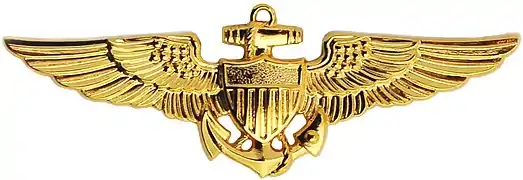 | ||
| Badge | Naval Aviator insignia | ||
|---|---|---|---|
| 1st Row | Medal of Honor | ||
| 2nd Row | Navy Distinguished Service Medal w/ two 5⁄16" Gold Stars | Silver Star Medal w/ three 5⁄16" Gold Stars | Legion of Merit w/ Combat "V" |
| 3rd Row | Distinguished Flying Cross w/ one 5⁄16" Gold Star | Bronze Star Medal w/ Combat "V" and one 5⁄16" Gold Star | Purple Heart w/ one 5⁄16" Gold Star |
| 4th Row | Air Medal w/ Strike/Flight Numeral 10 | Combat Action Ribbon | Navy Unit Commendation w/ one 3⁄16" bronze star |
| 5th Row | American Campaign Medal | World War II Victory Medal | Navy Occupation Service Medal |
| 6th Row | National Defense Service Medal w/ one 3⁄16" bronze star | Armed Forces Expeditionary Medal w/ two 3⁄16" bronze stars | Vietnam Service Medal w/ three 3⁄16" silver stars and one 3⁄16" bronze star |
| 7th Row | Republic of Vietnam Meritorious Unit Citation (Gallantry Cross) w/ palm | Republic of Vietnam Campaign Medal w/ 1960- device | Navy Pistol Marksmanship Medal w/ "E" device |
Medal of Honor citation
Stockdale's official Medal of Honor citation reads:
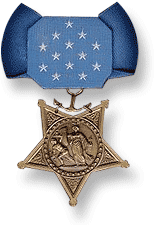
For conspicuous gallantry and intrepidity at the risk of his life above and beyond the call of duty while senior naval officer in the Prisoner of War camps of North Vietnam. Recognized by his captors as the leader in the Prisoners' of War resistance to interrogation and in their refusal to participate in propaganda exploitation, Rear Adm. Stockdale was singled out for interrogation and attendant torture after he was detected in a covert communications attempt. Sensing the start of another purge, and aware that his earlier efforts at self-disfiguration to dissuade his captors from exploiting him for propaganda purposes had resulted in cruel and agonizing punishment, Rear Adm. Stockdale resolved to make himself a symbol of resistance regardless of personal sacrifice. He deliberately inflicted a near-mortal wound to his person in order to convince his captors of his willingness to give up his life rather than capitulate. He was subsequently discovered and revived by the North Vietnamese who, convinced of his indomitable spirit, abated in their employment of excessive harassment and torture toward all of the Prisoners of War. By his heroic action, at great peril to himself, he earned the everlasting gratitude of his fellow prisoners and of his country. Rear Adm. Stockdale's valiant leadership and extraordinary courage in a hostile environment sustain and enhance the finest traditions of the U.S. Naval Service.[13]
Later life and death

Stockdale retired to Coronado, California, as he slowly succumbed to Alzheimer's disease.[35] He died from the illness on July 5, 2005. He was 81. Stockdale's funeral service was held at the Naval Academy Chapel and he was buried at the United States Naval Academy Cemetery.
Legacy
The Vice Admiral James Bond Stockdale Award for Inspirational Leadership is a United States Navy award established in 1980 by United States Secretary of the Navy Edward Hidalgo to honor the inspirational leadership of Stockdale. The award was first made in 1981.[36]
The U.S. Navy has named a number of structures after Stockdale, including the Arleigh Burke-class guided missile destroyer USS Stockdale (DDG-106), christened on May 10, 2008.[37] At the Naval Air Station North Island in Coronado, California, the main gate (inaugurated on August 30, 2007) and the headquarters building for the Pacific Fleet's Survival, Evasion, Resistance and Escape (SERE) school were both named in his honor. In July 2008, a statue of him was erected in front of Luce Hall at the U.S. Naval Academy; the hall which houses the Vice Admiral James B. Stockdale Center for Ethical Leadership.[38]
In 1976, he received the Golden Plate Award of the American Academy of Achievement.[39][40]
Stockdale Center, the student center at Monmouth College in Monmouth, Illinois, which he attended prior to transferring to the Naval Academy, was dedicated in his honor in 1989.[41]
He was enshrined in the National Aviation Hall of Fame in 2002.[42]
The Admiral James & Sybil Stockdale Arena at South Kent School was named after Stockdale and his wife in April 2014.[43]
In October 2014, Airbase Arizona of the Commemorative Air Force placed on display a restored Grumman AF-2S Guardian (BuNo 126731) flown by VADM Stockdale early in his Navy career with his name on the canopy rail and all markings as they were when he flew the aircraft in the 1950s.
Stockdale's naval experiences and his leadership decisions while senior Naval officer in prison in North Vietnam are an integral part of every Midshipman's educational experience at Annapolis.
A luxury suite at the Loews Annapolis Hotel, where Perot announced his candidacy, was named in Stockdale's honor.
The Abingdon-Avon High School Auditorium in Abingdon, Illinois has been named "Stockdale Auditorium" in his honor.
Electoral history
- 1992 election for U.S. President/Vice President – popular vote share
Writings by James Stockdale
- Books
- Taiwan and the Sino-Soviet Dispute, Stanford, California, 1962.
- The Ethics of Citizenship, University of Texas at Dallas, 1981, Andrew R. Cecil lectures on moral values in a free society featured Stockdale and other speakers.
- James Bond Stockdale Speaks on the "Melting Experience: Grow or Die", Hoover Institution, Stanford, 1981 speech to the graduating class of John Carroll University in Cleveland, Ohio.
- A Vietnam Experience: Ten Years of Reflection, Hoover Institution, Stanford, 1984, ISBN 0-8179-8151-9.
- In Love and War: The Story of a Family's Ordeal and Sacrifice During the Vietnam Years
- Courage Under Fire: Testing Epictetus's Doctrines in a Laboratory of Human Behavior, Hoover Institution, Stanford, 1993, ISBN 0-8179-3692-0.
- Thoughts of a Philosophical Fighter Pilot, Hoover Institution, Stanford, 1995 ISBN 0-8179-9391-6.
- Other writings
See also
| Wikimedia Commons has media related to James Stockdale. |
- List of Medal of Honor recipients for the Vietnam War
- List of United States presidential candidates (1856–present)
- List of Mount Holyoke College people
- List of United States Naval Academy alumni (Medal of Honor)
- List of prisoners of war
References
- Stockdale's given names--"James Bond"--are unrelated to James Bond, the hero of Ian Fleming's spy novels. Fleming had never heard of Stockdale when he coined the name long after the latter's birth ("Navy Hero: James Bond in His Own Right". The Pittsburgh Press. August 16, 1977. p. 9. Retrieved March 14, 2017 – via Newspapers.com.).
- Havel, James T. (1996). The candidates – James T. Havel – Google Books. Retrieved May 30, 2013 – via Google Books.
- Register of Alumni, United States Naval Academy, 1991.
- "Stockdale, James Bond". nationalaviation.org. Retrieved February 15, 2017.
- Moise, p. 78
- Moise, p. 82
- Moise, p. 83
- "Essay: 40th Anniversary of the Gulf of Tonkin Incident".
- Schudel, Matt (March 19, 2016). "William B. Bader, official who helped uncover CIA, Defense abuses, dies at 84". The Washington Post. ISSN 0190-8286. Retrieved April 16, 2016.
- Lowry, Timothy S. (1989). Valor. New York: Berkeley Books. pp. 13–31. ISBN 0425119165.
- Lowry, Timothy S. (1989). Valor. New York: Berkeley Books. pp. 17–31. ISBN 0425119165.
- "Admiral James B. Stockdale, USN, Biography and Interview". www.achievement.org. American Academy of Achievement.
- "Medal of Honor citations". Congressional Medal of Honor Society. Congressional Medal of Honor Society. June 8, 2009. Retrieved February 22, 2020.
- Stracener, William (October 3, 1982). "Former POW says Vietnam was a 'sellout'". UPI. Retrieved December 13, 2018.
- Adams, Lorraine (March 11, 1992). "Perot's Interim Partner Spent 7½ Years As Pow", The Dallas Morning News, March 11, 1992. Retrieved on 2008-07-02 from http://community.seattletimes.nwsource.com/archive/?date=19920331&slug=1483968. "He was one of the Alcatraz Gang – a group of 11 prisoners of war who were separated because they were leaders of the prisoners' resistance."
- Rochester, Stuart; and Kiley, Frederick. "Honor Bound: American Prisoners of War in Southeast Asia, 1961–1973", 2007, Naval Institute Press, ISBN 1-59114-738-7, via Google Books, p. 326. Accessed July 8, 2008.
- Stockdale, James B. "George Coker for Beach Schools", letter to The Virginian-Pilot, March 26, 1996.
- Johnston, Laurie (December 18, 1974). "Notes on People, Mao Meets Mobutu in China". The New York Times. Retrieved May 3, 2010. December 18, 1974
- Kimberlin, Joanne (November 11, 2008). "Our POWs: Locked up for 6 years, he unlocked a spirit inside". The Virginian Pilot. Landmark Communications. pp. 12–13. Retrieved November 11, 2008.
- Robbins, James S. (January 2014). "The Alcatraz Gang: Eleven American POWs in Hanoi's Notorious Camp". World Affairs Journal. Retrieved December 13, 2018.
Lamothe, Dan (March 4, 2015). "Families of Vietnam POWs confront a painful set of anniversaries". The Washington Post. Retrieved December 13, 2018. - Collins, Jim (date unknown). The Stockdale Paradox. JimCollins.com. Retrieved on July 2, 2008 from http://www.jimcollins.com/lab/brutalFacts/.
- "The Stockdale Paradox". VenChar. Retrieved May 30, 2013.
- Wisckol, Martin (August 11, 2008). "POW mate calls McCain 'liar' over 'turncoat' charge". OC Register. Orange County, California. Retrieved December 13, 2018.
- Solis, Lieutenant Colonel Gary D. (1989). "Part IV Aftermath and Echos" (PDF). Marines and Military Law in Vietnam: Trial By Fire (PDF). Washington, D.C.: History and Museums Division, United States Marine Corps. pp. 218–221. LCCN 77-604776.
- "About U.S. Naval War College". www.usnwc.edu.
- George C. Wilson (August 20, 1980). "President of the Citadel Quits In Controversy Over 'Reform'". Washington Post. Retrieved June 8, 2020.
- https://www.hoover.org/research/thoughts-philosophical-fighter-pilot
- https://medium.com/stoicism-philosophy-as-a-way-of-life/stoicism-and-the-military-261e8b1e097#id_token=eyJhbGciOiJSUzI1NiIsImtpZCI6ImUxOTdiZjJlODdiZDE5MDU1NzVmOWI2ZTVlYjQyNmVkYTVkNTc0ZTMiLCJ0eXAiOiJKV1QifQ.eyJpc3MiOiJodHRwczovL2FjY291bnRzLmdvb2dsZS5jb20iLCJuYmYiOjE2MDg0MTA1MTksImF1ZCI6IjIxNjI5NjAzNTgzNC1rMWs2cWUwNjBzMnRwMmEyamFtNGxqZGNtczAwc3R0Zy5hcHBzLmdvb2dsZXVzZXJjb250ZW50LmNvbSIsInN1YiI6IjEwMzk4MTI5MzgxODc0NjYxMTA4NCIsImVtYWlsIjoibHljdXJndXMyMDA3QGdtYWlsLmNvbSIsImVtYWlsX3ZlcmlmaWVkIjp0cnVlLCJhenAiOiIyMTYyOTYwMzU4MzQtazFrNnFlMDYwczJ0cDJhMmphbTRsamRjbXMwMHN0dGcuYXBwcy5nb29nbGV1c2VyY29udGVudC5jb20iLCJuYW1lIjoiTWljaGFlbCBQYXRyaWNrIE11bHJveSIsInBpY3R1cmUiOiJodHRwczovL2xoMy5nb29nbGV1c2VyY29udGVudC5jb20vYS0vQU9oMTRHaWpnR1RCSDdYQ0FpNml6WGl4XzRoZmJkckhxVWVYTnItMURTOXkwTkE9czk2LWMiLCJnaXZlbl9uYW1lIjoiTWljaGFlbCBQYXRyaWNrIiwiZmFtaWx5X25hbWUiOiJNdWxyb3kiLCJpYXQiOjE2MDg0MTA4MTksImV4cCI6MTYwODQxNDQxOSwianRpIjoiMDljOWZlN2Q4ZGUwODI5YTY2YzU2OTVlYTAzZjZjOTA3YzhlNGI4MyJ9.oqCqIeNqJ9dxZqHvrHWPXq7HtjWZKa6HTo1_v_4-Jvrg4d-8LbVGjvMug5UA8WmMbfqG2pfOXODLh4e4tqZut5DaLeUNT6lp5BnGafKWOLZvmNyPTe3AA1axVZ4REpzLTD4LrDM-E1-sNywWM7csXPEyNYvAspg3xl2IXbszWbxMmHmQZoBFC1vqksqKD2tCuTVn5MmPRuHtu-cYPmhJvdkXTw1qvkQfg_GbwWxP4l8OaJ3lCaUglgWv1XINgmkQSrujqqJ6E9HwR7nafLuaveikxOSRHJhFTuV9BViwV1B73icvA0mv-In9dEpJCWpuyitwQK0g5TdOFaNsPBER8Q
- The Nation, "The Rockford File," October 26, 1992 (Volume 255).
- "The Political Fray". CNN.
- "James Stockdale Interview". Debating Our Destiny. PBS. September 4, 1999. Retrieved August 16, 2011.
- Schudel, Matt (November 10, 2011). "Hal Bruno, former ABC News political director, dies at 83". Washington Post. Retrieved November 26, 2011.
- Weber, Bruce (November 9, 2011). "Hal Bruno, Director of Election Coverage at ABC, Dies at 83". New York Times. Retrieved November 26, 2011.
- "Dennis Miller talks about Admiral James Stockdale" – via www.youtube.com.
- "Admiral Stockdale official website". Archived from the original on July 7, 2005. Retrieved May 5, 2007.
- "Navy Legend Vice Adm. Stockdale Led POW Resistance". Retrieved September 13, 2017.
- "Welcome to Navy Forces Online Public Sites". Stockdale.navy.mil. April 9, 2010. Retrieved May 30, 2013.
- "Vice Admiral James B. Stockdale Center for Ethical Leadership". Usna.edu. January 24, 2013. Retrieved May 30, 2013.
- "Golden Plate Awardees of the American Academy of Achievement". www.achievement.org. American Academy of Achievement.
- "Our History Photo: Pioneering Women of Achievement: Captain Grace Murray Hopper, USN, famed inventor, and developer of COBOL computer programming language, receives the Academy's Golden Plate Award from Admiral James B. Stockdale, USN, Medal of Honor recipient, during the 1983 Summit in San Diego". American Academy of Achievement.
- "About the Stockdale Center". Retrieved March 12, 2014.
- National Aviation Hall of Fame, 2002
- "New Rink Named The Admiral James & Sybil Stockdale Arena". South Kent School. Retrieved November 7, 2014.
Online sources
- Interview with Jim Lehrer on 1992 Vice-Presidential debate
- Hoover Institution Biography (archived)
- Washington Post obituary for Stockdale July 6, 2005
- Holmes, Steven A. (July 6, 2005). "James Stockdale, Perot's Running Mate in '92, Dies at 81". The New York Times. Retrieved May 5, 2010.
- The Guardian report on Stockdale's death July 2005
- Admiral Stockdale's Personal Webpage (archived)
- Memorial Service for Admiral James B. Stockdale (archived)
- Naval Academy Tribute to Stockdale
- United States Navy Announces the Death of Retired Vice Adm. James B. Stockdale (archived)
- Mahler, Jonathan (December 25, 2005). "The Prisoner". The New York Times. Retrieved May 5, 2010.
- Naval War College: Past presidents
- Oil Portrait of James B. Stockdale (archived) by Margaret Holland Sargent
- "Son of Navy POW Recounts Father's Heroism in Vietnam". DoD (via American Forces Press Service). November 8, 2013. Archived from the original on January 13, 2014.
Additional references
Apart from the works written by Stockdale himself, the following work refers extensively to Stockdale's involvement in the Tonkin Gulf:
- Edwin E. Moise, Tonkin Gulf and the Escalation of the Vietnam War UNC Press North Carolina 1996 ISBN 0-8078-2300-7
The following book is based on the series of lectures delivered for the course in moral philosophy established at the Naval War College by Admiral Stockdale in 1978, when Stockdale was president of the college. The course was designed by Stockdale and Professor Joseph Brennan, who continued to teach it after Stockdale retired from the Navy. The Foreword was written by Stockdale.
- Joseph Gerard Brennan, FOUNDATIONS OF MORAL OBLIGATION: The Stockdale Course, Presidio Press, Novato, California (1994) ISBN 0-89141-528-9
External links
| Military offices | ||
|---|---|---|
| Preceded by Huntington Hardisty |
President of the Naval War College 1977–1979 |
Succeeded by Edward F. Welch Jr. |
